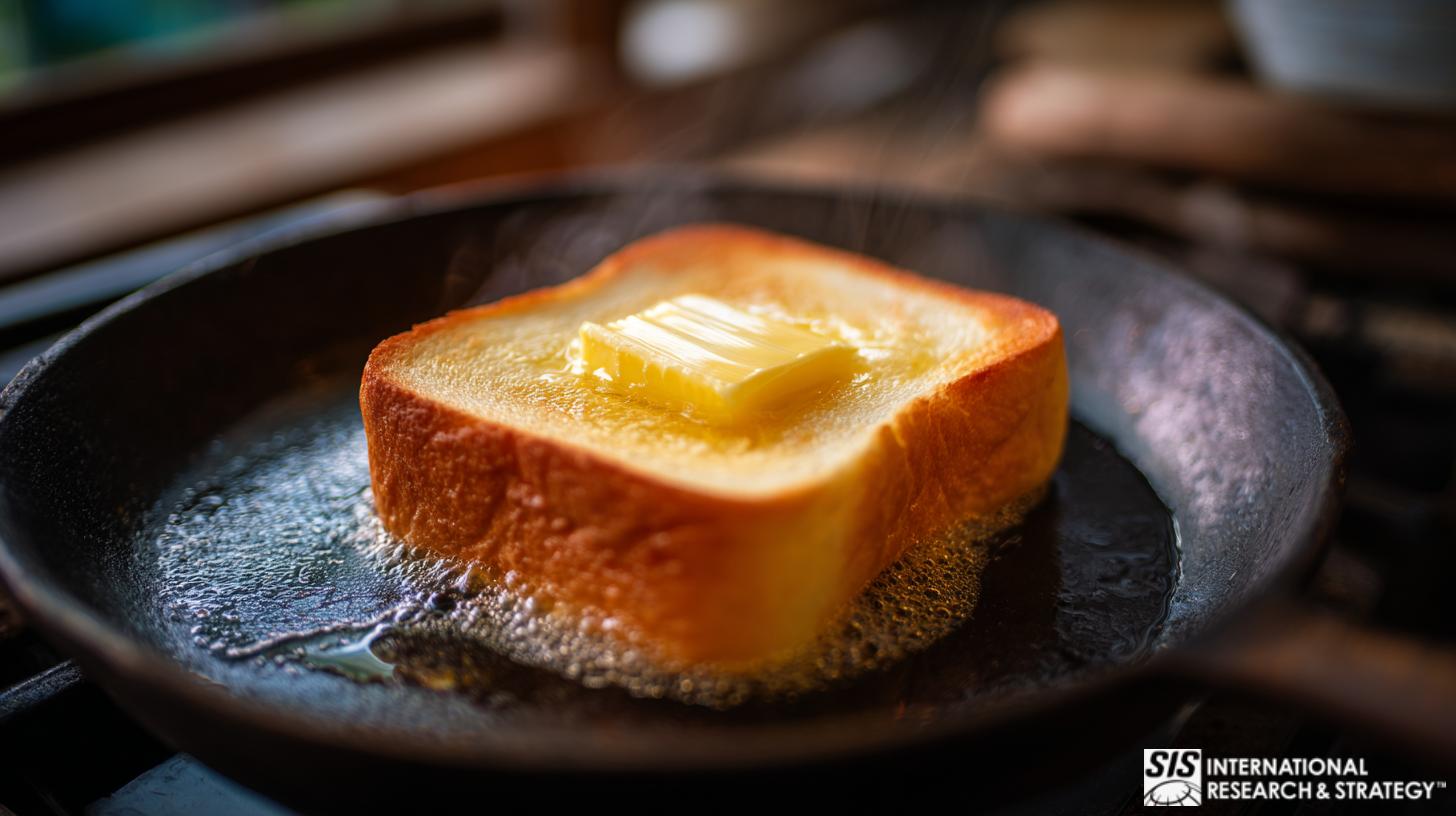黃油市場研究

Butter market research helps businesses understand changing dietary preferences, health considerations, and economic conditions, enabling them to tailor their products and strategies to effectively meet consumer demands.
Have you ever wondered about the ins and outs of the butter market? Butter remains a vital ingredient in kitchens worldwide. Its market reflects changing consumer preferences and industry innovations. That’s why butter market research explores the butter market in detail, shedding light on its evolution, current landscape, and future trends.
What Is Butter Market Research?
Butter market research delivers insights into market trends, consumer behavior, and competitive landscapes. Businesses can make informed decisions to enhance their market presence and profitability by studying factors such as pricing, packaging, and branding. This market research is also key in identifying emerging trends and opportunities in the butter market. Keeping up with market developments allows businesses to capitalize on new trends and gain a competitive advantage.
Why Do Businesses Need Butter Market Research?
Butter market research is essential for businesses seeking to thrive in a competitive market environment. Through comprehensive research, companies can gain valuable insights for their decision-making processes and drive strategic initiatives.
Moreover, market research helps businesses understand consumer preferences and trends, allowing them to develop products that align with market demands. For example, research may reveal a growing preference for organic or locally sourced butter, prompting businesses to adjust their product offerings accordingly.
Butter market research also enables businesses to identify new market opportunities and niches. By analyzing market trends and consumer behavior, businesses can uncover unmet needs and develop innovative products or services to address them. In any case, this market research offers numerous benefits for companies operating in the butter market. Here are some key advantages:
- 市場了解: Research helps businesses understand the butter market, including trends, consumer preferences, and competitor strategies.
- 產品開發: Businesses can develop new butter products that meet consumer demands and preferences by analyzing market data.
策略規劃: It enables businesses to develop strategic plans that align with market trends and dynamics, helping them stay competitive. - 風險管理: Butter market research helps businesses identify potential risks and challenges, allowing them to mitigate these risks effectively.
- 競爭優勢: This market analysis provides businesses with insights into competitor strategies and market positioning, enabling them to gain a competitive edge.
Who Uses Butter Market Research?

Butter Producers use market research to understand consumer preferences, develop new products, and identify market trends.
- 零售商 rely on butter market research to understand consumer demand for butter products, optimize pricing strategies, and enhance product placement in stores.
- Food Service Providers leverage market research to understand consumer preferences and trends in the butter market. This helps them create menus that appeal to their target audience and differentiate themselves from competitors.
- Distributors use market research to understand the demand for butter products in different regions, optimize distribution channels, and identify new business opportunities. This helps them effectively manage their inventory and expand their market reach.
When to Conduct Butter Market Research
Butter market research should be conducted regularly to stay updated with the latest trends and developments in the market. Some key times to conduct market research include:
- Before Launching a New Product: Conducting market research before launching a new butter product can help businesses understand consumer preferences and market demand, ensuring that the product meets the target audience’s needs.
- When Expanding into New Markets: Market research is essential to understand consumers’ unique preferences and trends in those markets.
- When Planning Marketing Campaigns: Market research can help businesses develop effective marketing campaigns by understanding consumer behavior and preferences.
- Regularly to Stay Competitive: Regular market research helps businesses stay competitive by staying updated with the latest trends, consumer preferences, and competitor strategies.
- In Response to Changes in the Market: Market research should be conducted in response to changes in the market, such as shifts in consumer preferences, new regulations, or competitive threats.
Questions to Ask Before Conducting Butter Market Research
Before diving into comprehensive butter market research, it’s crucial to consider several key factors that can influence the outcomes of your analysis.
- Market Demand: What is the current and projected demand for butter in different regions and industries?
- 競爭格局: Who are the leading players in the butter market, and what are their market shares and strategies?
- 消費者偏好: What factors drive consumer preferences for butter over alternative products?
- 監理環境: What are the regulatory standards and constraints affecting butter production and distribution?
- 技術進步: How do innovations impact butter manufacturing processes and product development?
SIS 國際專業知識和我們目前的市場回顧
At SIS International, we believe a thorough review of the butter market provides valuable insights for businesses seeking to understand industry trends and dynamics. Our approach to market analysis is focused on delivering meaningful information that adds value to potential clients navigating the complexities of the butter industry.
In our current market review, we observe notable trends reshaping the butter market. Consumer demand for natural and premium butter products is rising, driven by health-conscious preferences and a desire for authentic food experiences. This trend underscores the importance of product quality and transparency in consumer purchasing decisions.
From a competitive standpoint, the butter market is characterized by evolving strategies among key players to differentiate their offerings and capture market share. Innovations in product formulations, packaging, and marketing reflect efforts to meet diverse consumer needs and preferences.
Expected Results from SIS’s Butter Market Research
From SIS International’s butter market research, businesses can expect a comprehensive analysis that provides valuable insights and actionable recommendations. Some expected results from the research might include:
Market Size and Growth Projections:
An estimate of the current size of the butter market and forecasts for its growth over a specified period, helping businesses understand the market potential.
Consumer Preferences and Trends:
Insights into consumer preferences regarding butter, such as preferences for organic, grass-fed, or flavored butter, as well as emerging trends in consumption patterns.
競爭格局分析:
An overview of the key players in the butter market, their market shares, strengths, weaknesses, and competitive strategies, enabling businesses to benchmark their performance and identify opportunities for differentiation.
分銷通路見解:
An analysis of the distribution channels for butter, including retail, food service, and online channels, to help businesses optimize their distribution strategy.
定價分析:
Information on pricing strategies and price points in the butter market, assisting businesses in setting competitive prices that maximize profitability.
監理和合規要求:
An overview of the butter market’s regulatory landscape, including food safety and labeling requirements, to ensure compliance and mitigate risks.
機會與挑戰:
Identification of potential opportunities for growth and expansion and challenges that businesses may face in the butter market.
建議和策略見解:
Based on the research findings, SIS provides strategic recommendations to help businesses capitalize on opportunities, overcome challenges, and achieve their objectives in the butter market.
新興市場與成熟市場

新興市場: These markets exhibit high growth potential driven by increasing urbanization, rising disposable incomes, and changing dietary preferences. Emerging economies in regions like Asia-Pacific and Latin America are experiencing a surge in butter consumption due to Westernization of diets and expanding middle-class populations.
成熟市場: Conversely, mature markets such as North America and Europe have well-established butter industries with relatively stable consumption patterns. These markets focus more on product innovation, sustainability, and health-conscious offerings to maintain market share.
Key Industries in the Butter Market
The butter market intersects with several key industries, each contributing to its diverse applications and demand.
- 食品飲料業: Butter is a fundamental ingredient in baking, cooking, and food processing. Major players in this industry, such as Nestlé (with brands like Carnation and Toll House), utilize butter in a wide range of products including pastries, desserts, sauces, and spreads.
- Personal Care and Cosmetics: Butter’s moisturizing and nourishing properties make it a sought-after ingredient in skincare and cosmetic formulations. Companies like L’Occitane and The Body Shop incorporate butter into their premium skincare lines.
- Pharmaceuticals: Certain pharmaceutical formulations require butter-derived compounds for their therapeutic effects. This niche application underscores butter’s versatility beyond culinary uses.
- 健康與保健: The health and wellness sector drives demand for specialty butters, including grass-fed, organic, and lactose-free varieties. Brands like Kerrygold and Organic Valley cater to health-conscious consumers seeking premium butter products.
Leading Players in the Butter Market
The butter market is dominated by several key players, encompassing renowned brands and established companies.
- Kerrygold: Known for its premium Irish butter from grass-fed cows, Kerrygold has a strong presence in international markets.
- Land O’Lakes: A prominent American dairy cooperative, Land O’Lakes produces various butter products, including salted, unsalted, and spreadable options.
- Fonterra Co-operative Group: Based in New Zealand, Fonterra is a leading exporter of dairy products, including butter, to global markets.
- Lactalis Group: A multinational dairy company, Lactalis owns popular butter brands such as President and Président.
- Arla Foods: This Scandinavian cooperative is a major player in the European butter market, offering a range of butter products catering to diverse consumer preferences.
Regional Insights in the Butter Market
The global butter market exhibits diverse regional dynamics driven by cultural preferences, economic conditions, and consumer behaviors. Here are insights into key regions shaping the butter industry:
歐洲: Europe holds a prominent position in the butter market, with countries like France, Germany, and Ireland renowned for their premium butter products. European consumers prioritize quality and heritage, leading to the popularity of artisanal and traditional butter varieties. Regulatory frameworks in Europe also emphasize dairy product standards, influencing market dynamics.
北美: The butter market in North America is characterized by a mix of established brands and emerging speciality producers. Consumer demand for natural, grass-fed, and organic butter continues to rise, reflecting a broader trend toward healthier and sustainable food choices. The United States and Canada are major consumers and producers of butter, with a growing emphasis on product differentiation and innovation.
亞太: Emerging economies, including China and India, are experiencing increased butter consumption driven by urbanization and Western influences. Rising disposable incomes and changing dietary habits contribute to this region’s growing demand for butter-based products. Local dairy industries are also evolving to meet consumer preferences for quality and variety.
拉美: Latin America presents a growing market for butter, particularly in countries like Brazil and Mexico. Urbanization and a burgeoning middle class contribute to rising demand for dairy products, including butter, in retail and foodservice sectors. Domestic production and import dynamics shape the availability and pricing of butter in Latin American markets.
Opportunities in the Butter Market
The butter market presents several opportunities for businesses to capitalize on emerging trends and consumer preferences. Some key opportunities in the butter market include:
- Growing Demand for Organic and Natural Products: A growing consumer preference for organic and natural butter products presents an opportunity for businesses to expand their product offerings in this segment.
- Innovative Packaging Solutions: With an increasing emphasis on sustainability, businesses have an opportunity to develop innovative and eco-friendly packaging solutions for butter products.
- 拓展新市場: Emerging markets offer businesses untapped opportunities to expand their presence in the butter market and cater to new consumer segments.
- Product Diversification: Businesses can diversify their product offerings by introducing new flavors, blends, and formulations to cater to evolving consumer preferences.
Challenges of the Butter Market for Businesses
While the butter market offers numerous opportunities, it also presents challenges that businesses must address to succeed. Some key challenges in the butter market include:
- Price Volatility: Fluctuations in butter prices can impact profit margins and pricing strategies, making it challenging for businesses to maintain stability.
- Health Concerns: Increasing awareness of health issues related to butter’s high saturated fat content has led to a shift towards healthier alternatives, which poses a challenge for traditional butter producers.
- 競賽: The butter market is highly competitive, with numerous players vying for market share. Businesses must differentiate their products and marketing strategies to stand out.
- 監理環境: Regulatory requirements related to food safety, labeling, and quality standards can pose challenges for businesses operating in the butter market.
Industry Attractiveness: Porter’s Five Forces Analysis of the Butter Market
Porter’s Five Forces framework is a valuable tool for assessing the attractiveness and competitiveness of an industry. It examines five key forces that shape industry dynamics and influence profitability. Here’s how these forces apply to the butter market:
1. Threat of New Entrants:
- The threat of new entrants into the butter market is relatively low due to significant barriers to entry. These barriers include high initial capital requirements for dairy farming and processing facilities, economies of scale enjoyed by established players, and stringent regulatory standards governing dairy production.
2. Bargaining Power of Suppliers:
- The bargaining power of suppliers, particularly dairy farmers and cream producers, can impact butter manufacturers. In regions with limited suppliers or during periods of supply shortage, suppliers may exert leverage over pricing and terms.
3. Bargaining Power of Buyers:
- The bargaining power of buyers, which include food manufacturers, retailers, and consumers, varies within the butter market. Large food manufacturers and retailers may have significant purchasing power, influencing pricing and distribution agreements. However, consumer preferences and brand loyalty can also impact buyer behavior.
4. Threat of Substitutes:
- The threat of substitutes, such as margarine, spreads, and plant-based butter alternatives, poses a moderate challenge to the traditional butter market. Consumer health trends and dietary preferences drive demand for alternative products, impacting butter consumption.
5. Competitive Rivalry Within the Industry:
- Competitive rivalry within the butter industry is moderate to high. Established players compete on product differentiation, quality, and distribution channels. To maintain market share, brands must differentiate themselves through unique offerings and marketing strategies.
How SIS International’s Services Help Businesses in the Butter Market
SIS國際,‘s butter market research provides valuable insights and analysis to businesses operating in the dairy industry. Here’s how their research services can help companies in the butter market:
消費者偏好:
安全資訊系統 conducts consumer research to understand preferences, attitudes, and behaviors related to butter consumption. This helps businesses tailor their products, marketing strategies, and branding to meet consumer demands and preferences.
Market Trends:
We track emerging trends in the butter market, such as the increasing demand for organic, grass-fed, or flavored butter varieties. This enables businesses to stay ahead of the curve and capitalize on emerging opportunities.
競品分析:
SIS International’s experts provide insights into the competitive landscape of the butter market, including key players, market shares, and competitive strategies. This information helps businesses understand their position in the market and develop strategies to differentiate themselves from competitors.
Regulatory Insights:
Our consultants provide information on relevant laws, regulations, and compliance requirements in different markets, helping businesses navigate legal complexities and avoid potential pitfalls.
市場區隔:
By segmenting the market based on demographics, psychographics, and consumption patterns, SIS International helps businesses more effectively identify and target specific consumer groups, allowing for more personalized marketing and product development.
產品創新:
Based on market research findings, SIS International helps businesses develop or refine their product offerings to better align with market opportunities and consumer preferences, encouraging innovation in product development.
供應鏈分析:
We also provide insights into supply chain dynamics, including sourcing, production, distribution, and logistics, helping businesses optimize their operations and reduce costs.

